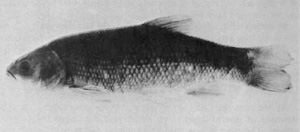Thicktail chub facts for kids
Quick facts for kids Thicktail chub |
|
|---|---|
 |
|
| Conservation status | |
| Scientific classification | |
| Genus: |
Gila
|
| Species: |
crassicauda
|
The thicktail chub (Gila crassicauda) was a type of minnow, which is a small freshwater fish. It lived in the calm, weedy waters of the Sacramento River and San Joaquin Rivers. These rivers are in the Central Valley of California.
This fish was once very common in many places. It lived in lowland lakes, marshes (wetlands), ponds, and slow parts of rivers. During years with lots of rain, it even swam in the surface waters of San Francisco Bay. The thicktail chub was one of the most common fish in California. Native American people often ate them. In their ancient trash piles, called middens, thicktail chub bones made up 40% of the fish remains found.
About the Thicktail Chub
This chub was a favorite food for the Native American people. They lived near Clear Lake and in the Central Valley. Later, many thicktail chubs were caught by commercial fishermen. These fishermen sold the fish in the San Francisco market.
The thicktail chub was a strong, heavy fish. It had a thick tail and a small, cone-shaped head. The color of its back ranged from greenish-brown to purplish-black. Its sides and belly were yellow. This fish could grow to be almost ten inches long.
We do not know much about how it behaved. However, it was probably a carnivore. This means it ate other animals. It likely fed on small fish and invertebrates, which are animals without backbones, like insects.
Why the Thicktail Chub Disappeared
The main reason the thicktail chub became extinct was changes to the Central Valley. Much of its home was turned into farmland. Most of its habitat was destroyed. This happened because people drained wetlands and marshes. They also built dams and moved water for irrigation. All these changes meant the fish lost the slow-moving water it needed to live.
Other types of fish also caused problems. New species of fish were brought into the area. These new fish competed with the thicktail chub for food and space. This also helped lead to its extinction. The very last known thicktail chub was caught on April 16, 1957.
See also
 In Spanish: Gila crassicauda para niños
In Spanish: Gila crassicauda para niños


